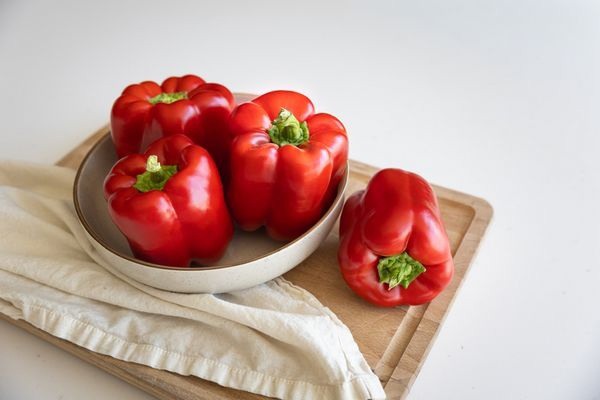Consumption of sweet peppers continues to rise, in line with consumers following healthier diets. Not only are sweet peppers diverse in their use, they also come in diverse shapes, colors, sizes, and flavors. As a result, this vegetable aligns well with today’s consumer demands, explaining Sakata Seed America’s large offering in this category. “It is our desire to supply a portfolio that accommodates all key pepper segments in North America, including variety of colors, shapes, and slotting associated with the market demands,” says James Galante, Sweet Pepper & Tomato Product Manager with Sakata Seed. With each region having a specific need and those needs depending on the environmental demand and the customer’s finished product, it is no surprise the product offering is extensive.
To accomplish their goals, Sakata has developed an extensive trialing program driven by an experienced product development team. This program covers all of the key growing regions from the western part of the U.S. to the East, and all throughout Mexico. Specific separate genetics focus on the different markets in these regions.
Key bell pepper varieties for growers
From a grower perspective, the preference for a variety varies depending on their location. On the East Coast, for instance, Nitro S10® and Big Stack S10® bell peppers are in high demand. Nitro brings high marketable quality along with yield, combined with resistance to phytophthora, TSWV, and bacterial leaf spot race 10. Big Stack S10® is a major player for the northeastern market. In addition to its jumbo size, high quality, and early maturity, this variety brings a high level of Phytophthora resistance to the grower’s program, which is becoming a major challenge for open field production.
On the West Coast, on the other hand, Double Up has stood the test of time as this variety continues to deliver yield year after year. More recently, Shasta was brought to market. This newer variety has been out commercially for about a year and has gained its spot in the fresh and processing markets due to its incredible final red color, vigorous plant structure as well as high adaptability and resistance to TSWV.
 © Sakata Seed
© Sakata Seed
Shasta pepper variety.
In the Southeastern U.S., Payline S10® is a new release offering a vigorous plant and bacterial resistance that brings growers security in crop protection. In addition, the plant frame carries into multiple harvests.
 © Sakata SeedThe new Delite S10® series (Crimson Delite S10®, Amber Delite S10® and Golden Delite S10®) are firing on all cylinders in North America. “They add market leading resistance package (TSWV + S10®) as well as yields that exceed anything else in its segment.” Because this series is highly adaptable, high yielding, and early to maturity, it’s suitable for all growing regions in the U.S. “The uniformity in size and maturity among the three colors is also a big advantage, as they can be planted and harvested at the same time,” shared Anali Rodriguez, Western Product Development Manager.
© Sakata SeedThe new Delite S10® series (Crimson Delite S10®, Amber Delite S10® and Golden Delite S10®) are firing on all cylinders in North America. “They add market leading resistance package (TSWV + S10®) as well as yields that exceed anything else in its segment.” Because this series is highly adaptable, high yielding, and early to maturity, it’s suitable for all growing regions in the U.S. “The uniformity in size and maturity among the three colors is also a big advantage, as they can be planted and harvested at the same time,” shared Anali Rodriguez, Western Product Development Manager.
 © Sakata Seed
© Sakata Seed
Anali Rodriguez.
Flavor, convenience, and cost are critical for consumers
While growers are looking for disease resistance, yields, and uniformity, consumer interests are different. “Historically, consumer trends have been heavily driven by esthetics and flavor experience,” commented Galante. “This remains true, however, convenience and cost are growing drivers for consumption.”
With that in mind, the most popular sweet pepper varieties for consumers include green to red bells, shishito, and snacking peppers. Within the bell pepper category, Nitro S10® is appealing as a place-pack shelf item because of its exceptional fruit quality and dark color. “It has thick walls and great shelf life to prevent waste,” Galante added. For Shishitos, Takara is the classic type that is perfectly bite-sized, rich in flavor, and produces the occasional spicy fruit to keep it interesting. Within the snacking segment, Sakata’s Delite series is attractive due to the vibrancy of the colors, their convenient small size, and most of all, their flavor. “This segment caters to everything around the consumer experience and is typically made up of a range of yellow, red, and orange types.” These peppers need to be bite-sized (2-3″ in length) and incorporate high-flavor whether consumed raw or cooked. “The peppers from the Delite series give open field growers an opportunity at outstanding yields while delivering equally outstanding flavor and quality experiences,” he mentioned.
 © Sakata Seed
© Sakata Seed
Nitro sweet pepper.
Shifts in pepper breeding
Overall, pepper breeding has undergone major shifts in the past decade, driven by advancements in technology for marker and key trait development. Breeders have much more precise genetic markers to work with in developing new, higher-quality resistance in their hybrid material. In addition to marker development, breeding has placed a major emphasis on the shifts in climate demands, such as heat and drought tolerance. “Developing resilience to meet disease and climate demands, while enhancing yields, remains the key priority for Sakata to deliver to our customers,” closed Galante.
 © Sakata Seed
© Sakata Seed
Takara pepper.
 For more information:
For more information:
Sakata Seed America
James Galante
Tel: (+1) 239-243-5952
[email protected]
Anali Rodriguez
Tel: (+1) 530-902-4337
[email protected]
www.sakatavegetables.com
Source: The Plantations International Agroforestry Group of Companies
